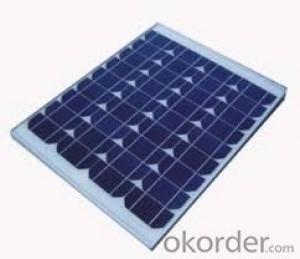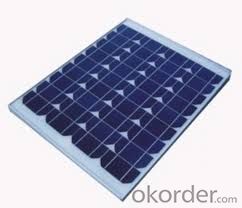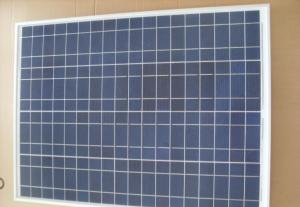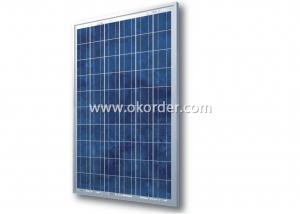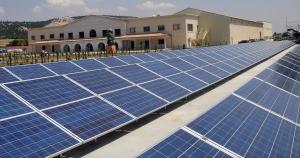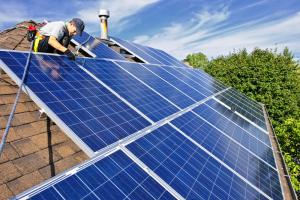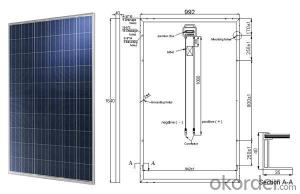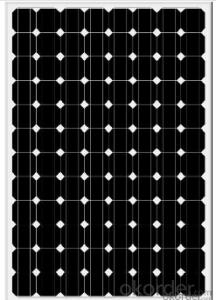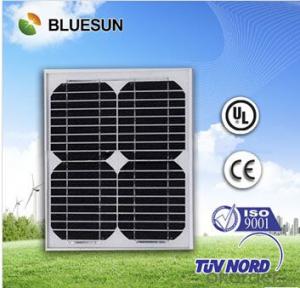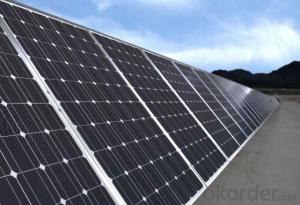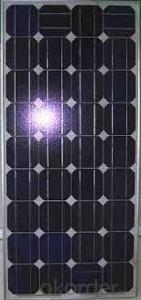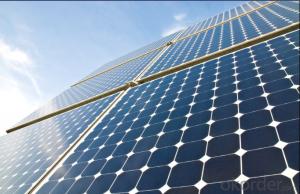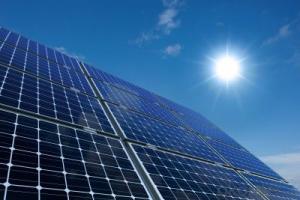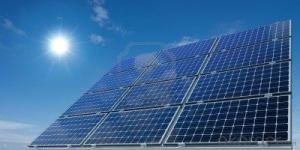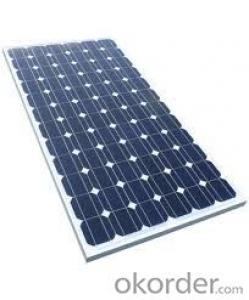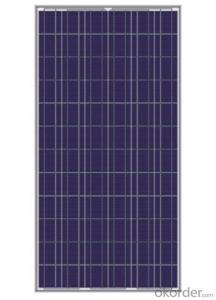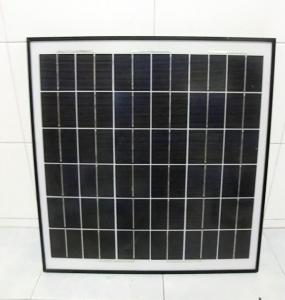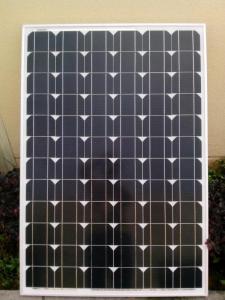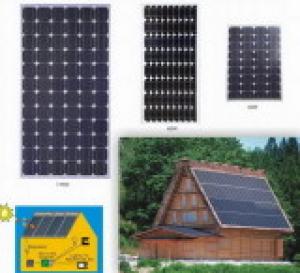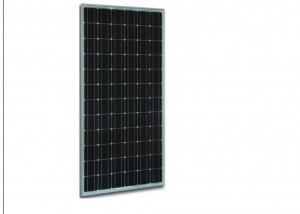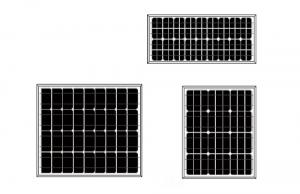International Space Station Solar Panels:Hot Sale 165W Monocrystalline Solar Panel with High Efficiency CNBM
- Loading Port:
- Qingdao
- Payment Terms:
- TT OR LC
- Min Order Qty:
- 10 set
- Supply Capability:
- 300000 set/month
OKorder Service Pledge
OKorder Financial Service
You Might Also Like
Monocrystalline Solar Panel with 165W
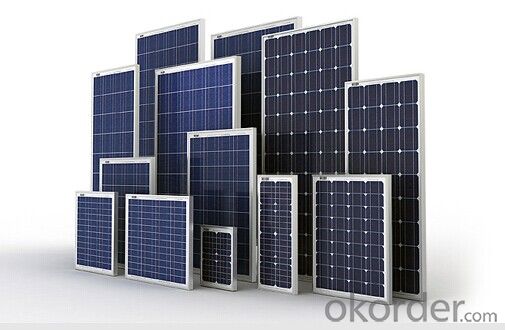
Monocrystalline Solar Modules
We offers a range of small, medium and large monocrystalline solar modules, designed for a range of requirements.
Specifications:
Tolerance | +/- 3% |
Cell | Monocrystalline silicon solar cells |
N0. of Cells | 72 (12 x 6) |
Dimension of Modules (mm) | 1581 x 809 x 40 |
Weight (kg) | 15.5 |
Limits:
Operating Temperature | -40~+85? |
Storage Temperature | -40~+85? |
Maximum System Voltage | 1000 VDC max. |
Hail Impact | Diameter of 28mm with impact speed of 86km/h |
Temperature and Coefficients:
NOCT | 48C+/-2? |
Voltage temperature coefficient (%/K) | -0.34 |
Current temperature coefficient (%/K) | 0.09 |
Power temperature coefficient (%/K) | -0.37 |
Characteristics:
Model: | SGM-160D | SGM-165D | SGM-170D |
Max-power voltage Vmp (V) | 34.5 | 35.4 | 35.8 |
Max-power current Imp (A) | 4.64 | 4.66 | 4.75 |
Open-circuit voltage Voc (V) | 41.75 | 43.6 | 43.32 |
Short-Circuit Current Isc (A) | 5.32 | 5.08 | 5.38 |
Max-power Pm(W) | 160 | 165 | 170 |
Model: | SGM-175D | SGM-180D | SGM-185D |
Max-power voltage Vmp (V) | 36.1 | 36.2 | 36.2 |
Max-power current Imp (A) | 4.85 | 4.97 | 5.11 |
Open-circuit voltage Voc (V) | 43.68 | 43.8 | 44.8 |
Short-Circuit Current Isc (A) | 5.49 | 5.48 | 5.51 |
Max-power Pm(W) | 175 | 180 | 185 |
STC: Irradiance 1000W/m2, Module temperature 25?, AM=1.5
Monocrystalline Solar Panels Specifications Range
Maximum Power (Pm) | Dimension | Weight | Operating Voltage (Vmp) | Operating Current (Imp) | Open Circuit Voltage (Voc) | Short Circuit Current (Isc) |
3W | 158x241x25mm | 0.5kg | 8.5V | 0.36A | 10.5V | 0.4A |
4W | 308x166x25mm | 0.77kg | 8.5V | 0.47A | 10.5V | 0.54A |
4W | 308.x166x25mm | 0.77kg | 16.8V | 0.24A | 21V | 0.27A |
5W | 296x215x25mm | 0.3kg | 16.8V | 0.48a | 21V | 0.54A |
10W | 286x406x25mm | 1.5kg | 16.8V | 0.59A | 21V | 0.66A |
12W | 286x406x25mm | 1.5kg | 16.8V | 0.71A | 21V | 0.8A |
14W | 286x541x25mm | 2kg | 16.8V | 0.83A | 21V | 0.96A |
16W | 286x541x25mm | 2kg | 17.2V | 0.93A | 21.5V | 0.99A |
18W | 296x541x25mm | 2.4kg | 18.8V | 1.07A | 21V | 1.2A |
20W | 296x641x25mm | 2.4kg | 17.2V | 1.15A | 21.5V | 1.24A |
24W | 541x451x25mm | 3.15kg | 16.8V | 1.14A | 21V | 1.56A |
26W | 541x451x25mm | 3.15kg | 17.2V | 1.51A | 21.5V | 1.63A |
30W | 296x966x25mm | 3.85kg | 16.8V | 1.78A | 21V | 2.03A |
36W | 541x641x35mm | 4.7kg | 16.8V | 2.14a | 21V | 2.4A |
40W | 541x641x35mm | 4.7kg | 17.2V | 2.33A | 21.5V | 2.5A |
55W | 1057x457x35mm | 6.6kg | 17.6V | 3.12A | 21.6V | 3.3A |
70W | 546x1196x35mm | 8.5kg | 16.8V | 4.15A | 21V | 4.7A |
75W | 546x1196x35mm | 8.5kg | 17.2V | 4.36A | 21.5V | 4.8A |
80W | 546x1196x35mm | 8.5kg | 17.6V | 4.55A | 21.6V | 4.9A |
110W | 1066x811x40mm | 11.8kg | 17.6V | 6.25A | 21.6V | 6.6A |
150W | 1066x811x40mm | 14kg | 34.4V | 4.36A | 43.2V | 4.7A |
- Q: Which is more efficient at producing energy? Reference(s) would be nice, but not required.
- Depends on the planet and solar panel. Generally, solar panels are more efficient according to these figures I bumped into. Photosynthetic efficiencies range from 0.% - 8%!
- Q: Can solar panels be installed on walls?
- Yes, solar panels can be installed on walls. While they are commonly mounted on rooftops for optimal sun exposure, they can also be installed on walls using specialized mounting systems. Wall-mounted solar panels are a viable option for locations with limited roof space or where the roof is not suitable for installation.
- Q: Can solar panels be installed on golf courses?
- Yes, solar panels can be installed on golf courses. In fact, many golf courses are adopting solar energy systems to reduce their carbon footprint and lower their energy costs. The large open spaces and ample sunlight available on golf courses make them ideal locations for installing solar panels. These panels can be placed on rooftops, parking structures, or even on the ground without interfering with the gameplay or aesthetics of the course.
- Q: I had installed over the summer a solar panel system on my house. Hers some infofor you: I live in MOThe system cost 25K (Rounded numbers)The Rebate from the utility company was about 0KThe expected tax rebate will be about 5KI have a home office from which I work and is 5% of my homes sq footage. My question is though I am getting a basic tax rebate, should I be able to claim part of this off as an expense for my home office?It seams logical since I used to deduct part of my electric bill and I there for should be able to write off part of this. I am, after all using electricity and getting a bill from the utility that is higher than it would be if I didn't have the office2. If so which amount should it be? The full 25K or something after the rebates.
- Home Office Write Off
- Q: Ok, so I've been having much success with the joule thief circuit and a LED, but i tried hooking it up to a small solar panel that can put out 2.5v on it's own, and can light up a white LED dimly by it self to the joule thief and it will not work ....my question is why? I already trouble shooted it, the circuit is not the problem, is it the amount of amps the small solar panel is capable of? not enough?
- Solar panels convert light energy to electrical energy with an efficiency of around 5%. A SMALL solar panel will only produce a small amount of power (watts) your joule thief circuit wont help because as you draw more current from the solar panel the voltage will drop; and your joule thief circuit just reduces the efficiency of the whole system Try adding another solar cell in series to get more voltage and more power.
- Q: I have tried researching on the internet and just cant find any real answer. I know that the amount of electricity produced when taking in the suns rays depends on the placement of the solar panels but I am just looking for ball park figures. Thanks
- Ultimately it depends on your utility and the country you're in. In countries like Germany, Spain and the UK, the utilities will pay a higher price for the power you produce then what they sell it to you at. Otherwise, in countries that don't have such arrangements, net metering is best where what you produce is discounted from the amount you buy per month therefore so long as you produce less than you use, you get the full retail rate, otherwise you may get only half the retail rate with some utilities. Obviously, the solar panels are rated and won't produce much more than the rated power, a 4 foot by 2 foot panel would usually be rated at 00 watts but in most situations will produce about 80 watts and would probably cost about $500 US installed. If you assume 8 hours of usable sunshine a day, 70% sunny days, a 25 year service life, monthly billing and 0 cents a kilo watt hour retail rate, you can expect at most a -.67% per annum return on your investment, that's a negative sign out front. Basically without any subsidies, you will lose money on the panel, sure you're get some money every month, about $.34 per month for that 00 watt panel but it won't make back it's money at at a rate of 0.0 per kwh. With subsidies it might be a good investment but it's still not a good deal without subsidies.
- Q: Do solar panels require direct sunlight to work?
- No, solar panels can still generate electricity even in indirect or diffused sunlight.
- Q: What is the difference between on-grid and off-grid solar systems?
- The main difference between on-grid and off-grid solar systems is how they are connected to the power grid. On-grid solar systems are connected to the local utility grid, allowing excess electricity generated by the solar panels to be fed back into the grid and credited to the homeowner. This means that on-grid systems rely on the grid for power during times when the sun is not shining, such as at night or during cloudy days. On the other hand, off-grid solar systems are not connected to the power grid and operate independently. These systems typically use batteries to store excess electricity generated during the day for use during periods of low or no sunlight. Off-grid systems are commonly used in remote areas where connecting to the grid is not feasible or cost-effective. Overall, the distinction lies in the connection to the power grid and the reliance on it for electricity supply.
- Q: i'm making a small solar panel powered fan but it cant run the cellphone vibration motor even i have place two x2 solar panel.
- Did okorder / . Possibly this could immediately instruct each and every one!
Send your message to us
International Space Station Solar Panels:Hot Sale 165W Monocrystalline Solar Panel with High Efficiency CNBM
- Loading Port:
- Qingdao
- Payment Terms:
- TT OR LC
- Min Order Qty:
- 10 set
- Supply Capability:
- 300000 set/month
OKorder Service Pledge
OKorder Financial Service
Similar products
Hot products
Hot Searches
Related keywords
